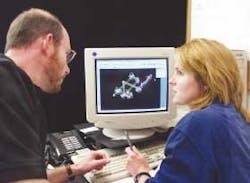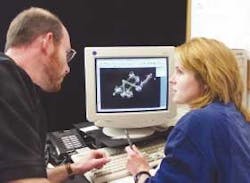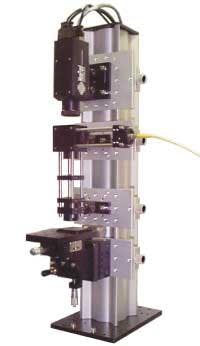Negotiating design options requires close cooperation
byBob Soales
null
The old clich?"Good, fast, cheap-pick one" is familiar to everyone who has ever designed and purchased custom optics. The truth, however, is that close cooperation between the designer and the manufacturer is absolutely essential for achieving the optimal balance of performance, timing, and cost in a lens element or assembly. This is particularly true in negotiating the myriad of options available for the specification, design, and manufacture of thin-film coatings (see Fig. 1).
Antireflection coatings
For lenses, we are generally concerned with antireflection (AR) coatings that can vary from simple quarter-wave magnesium fluoride (QWMF) layers to complex, multilayer coatings of refractory metal oxides. The reflection of an uncoated surface can represent a significant loss of transmitted light as well as a source for unwanted paths for light or "ghosts" (see Fig. 2). For fused silica at 550 nm, the reflection of an uncoated surface is about 3.5%. Crown glasses like BK7 reflect about 4%, while high-index flints like SF6 or SF11 reflect 8% per surface.
The application of a QWMF coating is the oldest and simplest way to reduce this surface reflection. Application of a coating that is one quarter-wave thick gives (theoretically) zero reflectivity when the index of the coating is the square root of the index of the substrate, assuming air is the incident medium. For any quarter-wave coating where the index match is not perfect, the reflection will still be lower than that of the uncoated substrate, but not zero. For example, a quarter wave of MgF2 deposited on fused silica at 550 nm gives a theoretical reflection of 1.7%, on BK7, 1.2%, and on SF 6, 0.06%. The reflection changes very slowly with wavelength, since for wavelengths other than the design wavelength, the condition that the coating thickness be one-quarter wave is not satisfied.
In many applications, especially those involving high-power lasers, even 1% reflection is too much. In such a case, more complicated coatings, using refractory metal oxides, are used. One such coating is commonly called a V-coat and consists of two quarter-waves of different materials. This coating can reduce the reflection of a fused silica or BK7 surface to less than 0.1%. These coatings also have the advantage of very high laser damage threshold. The disadvantage of V-coatings is in their spectral characteristics. While they have extremely low reflectivity at their design wavelength, the reflectivity rises rapidly for other wavelengths, becoming at some point higher than the reflectivity of the uncoated substrate.
More complicated AR coatings can minimize this disadvantage. Double or triple V-coat designs are available that give very low reflectivity for two wavelengths, such as 1064 and 532 nm to allow optics to be used in a system with YAG and doubled-YAG laser light. In general, the reflectivity at one of the two wavelengths will not be as low as a V-coat, but values of less than 0.25% at one wavelength and less than 0.5% at the other wavelength are common. Again, as with the V-coat, the reflectivity rises quickly away from the design wavelengths.
Another choice is the broadband anti reflection coating (BBAR). This coating provides an average reflectivity typically less than 0.5% over a relatively wide spectral range, for example, 425 to 675 nm or 500 to 800 nm. While the reflectivity is not as low at any point as it is for a V-coat, the average remains low over a wide range. Such a coating is typically used in applications where a range of wavelengths must be accommodated simultaneously, for example in photographic applications.
Reflective coatings
In choosing a reflective coating, the designer has options similar to those discussed above for antireflection coatings. The simplest reflective coatings are metals such as aluminum, silver, and gold. These are often used with a simple protective layer such as silicon monoxide. The choice of the overcoat is largely dependant on the wavelength region to be used. While silicon monoxide is perfectly acceptable in the visible, it has very strong absorption in the ultraviolet. For the ultraviolet (UV), aluminum is the metal of choice and the standard overcoat is magnesium fluoride. Care must be taken during the deposition process or the overcoat will become absorbing and the coating will be useless. Just measuring the reflectivity of coatings below 190 nm is a challenging task, beyond the capabilities of many optical shops.
Simple metal coatings have relatively low damage thresholds and significant absorption. A simple aluminum coating will absorb over 10% of some of the wavelengths in the near-IR. Even a good silver coating will absorb as much as 1% or more. Where such performance is unacceptable, the designer can turn to high-reflecting coatings made of stacks of dielectric materials, usually refractory metal oxides. The specific choice of materials depends primarily on the wavelength region and the characteristics of the laser source (if any) to be used. While these coatings are much more expensive than simple metal coatings, they allow the designer to achieve systems that operate at much higher energy levels and much lower loss.
As with simple metals coatings, for the UV region dielectric stacks pose special challenges because of the limited materials available. The durable metal oxides that are used for the visible and near-IR are highly absorbing in the UV. Softer materials such as the fluorides must be used. CVI has extensive experience in UV coatings. We not only have the experience necessary to deposit high-damage-threshold UV coatings, we have the specialized instrumentation necessary to measure the coatings to ensure the designer gets the performance he has specified.
As a very general rule, more complex coatings (such as those with more layers) tend to have lower damage thresholds. However, the proper choice of materials and deposition process can give the designer great latitude in controlling coating performance and damage threshold.
Refractory metal oxides such as ZrO2 or TiO2 have melting points too high to be reached by simple thermal evaporation. These materials are deposited by using an electron beam gun. Electrons from the gun hit the materials and melt them. Unfortunately, in some cases, when the electron beam has enough energy to melt the materials, it also has enough energy to decompose the compound into its constituent elements. In this case, it is often necessary to add oxygen to the coating chamber to make sure the proper oxide is reformed in the coating layer. Traces of uncombined metals in the coating lead to coatings with significantly lower damage thresholds. Incomplete oxidation or formation of the wrong oxide and the layer will have the wrong (usually lower) index. In short, the coating will not do what it is supposed to.
The use of techniques such as ion-assisted deposition (IAD) and ion-beam sputtering (IBS) can provide durable, stable coatings. As with all parts of the design effort, there is a trade here. These more advanced coating techniques are generally more expensive. In addition, while IAD can provide coatings that are more durable than e-beam coatings, these coatings can, in general have lower damage thresholds. IBS coatings are very stable and have very high damage thresholds, but are slow to deposit and thus expensive. Few optical fabrication shops can offer the designer a choice of all these coating techniques, and the more choices (thermal, e-beam, IAD, IBS) that a vendor can offer the designer, the more likely that the designer will be able to get the optimum combination of performance and price.
It is thus very important that the designer work with the coating vendor to determine the least expensive approach that will give him the desired performance with the proper margin. With close cooperation between the designer and the manufacturer, the result can be "Good, fast, cheap-pick three." Well, almost.
Bob Soales is vice president of applications engineering at CVI Laser, 200 Dorado Pl. SE, Albuquerque, NM 87123; e-mail: [email protected].null


